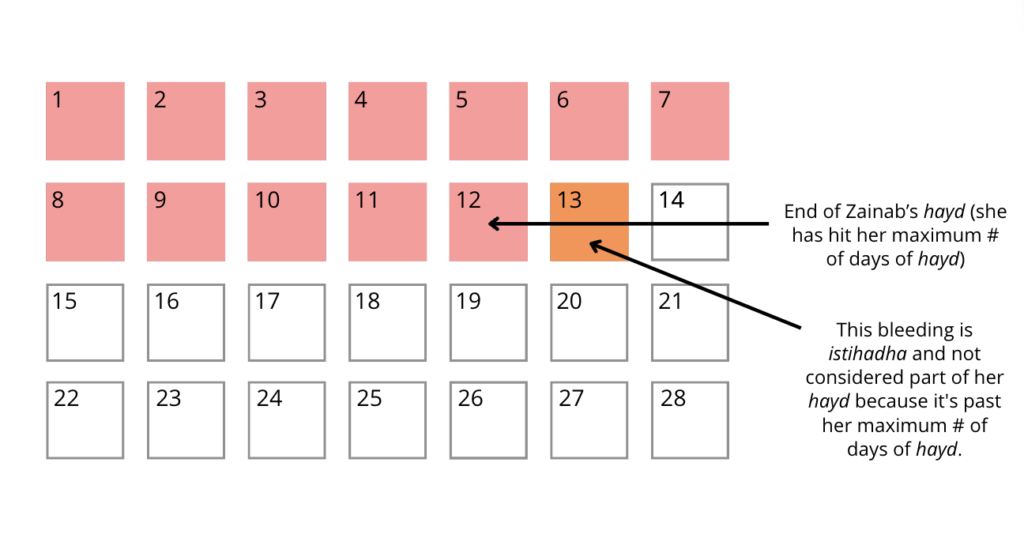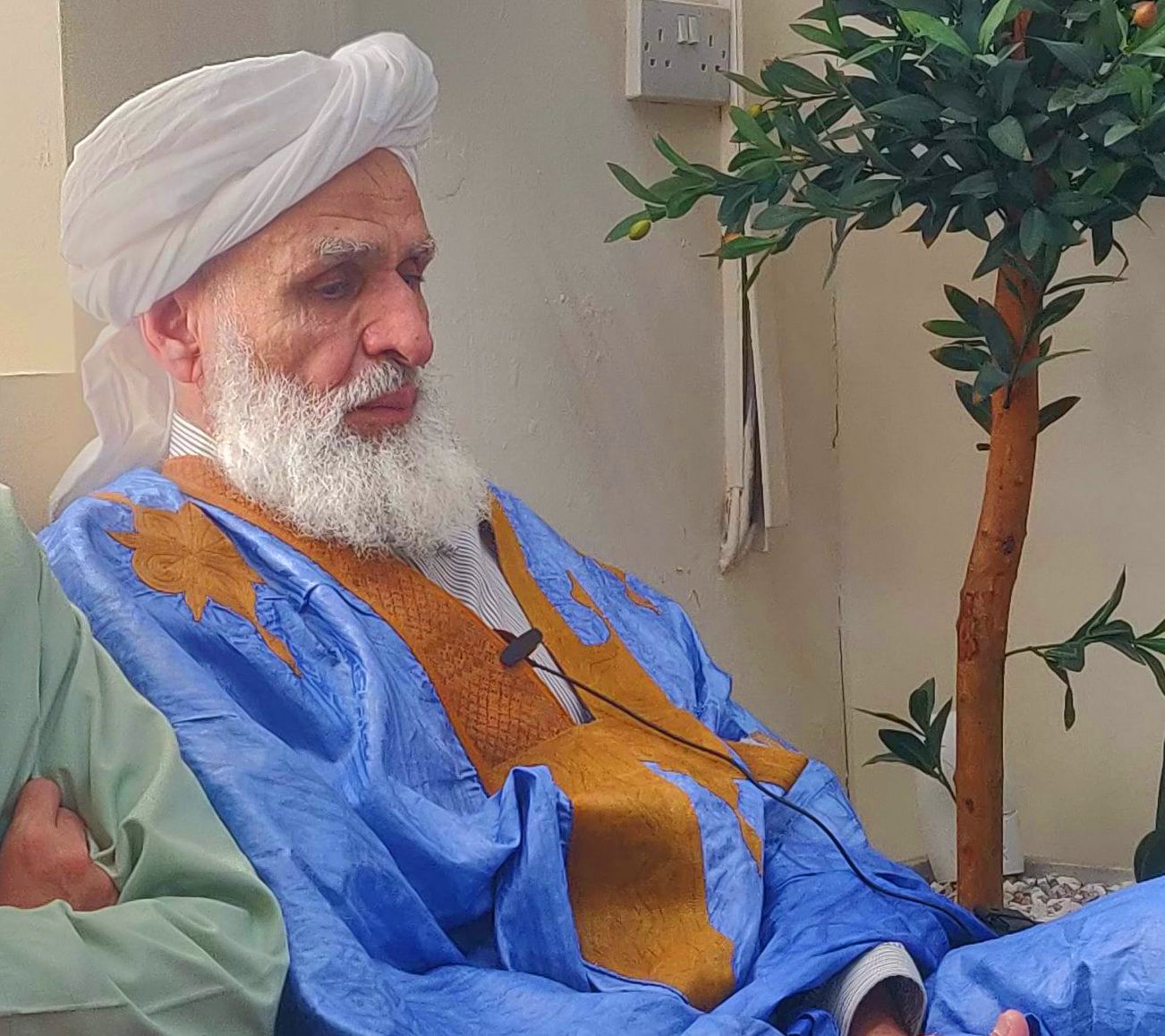﷽
A google search on Islam and menstruation yields unclear and contradictory information, either due to piecemeal presentation or lack of clarification on the source of the positions. Learning the fiqh related to acts of worship is part of fard al-ayn (what’s obligatory upon every person). Knowledge of the fiqh of menstruation is pertinent especially for women, as lack of knowledge in this area can jeopardize one’s worship, but also important for men to study.
Please consult a local scholar for specific, individualized questions.
What is Hayd?
- Hayd is often translated as menstruation, but there is a distinction between the medical and fiqhi definition of menstruation
- The medical definition of menstruation roughly means the shedding of the uterus lining.
- The fiqhi definion of hayd refers to vaginal bleeding that:
- Is not caused by injury or medication (i.e. it is “untriggered”)
- Does not come from a young girl or post-menopausal woman.
- Color – the color of hayd can only be the following:
- Yellow
- Orange
- Red
- Brown
- Brownish black
- Istihadha – Abnormal bleeding, i.e any bleeding that does not meet the fiqhi definition of hayd.
- Ṭuhr (purity) – everything besides hayd (includes istihadha and no bleeding).
How to Calculate Hayd Length
Some things to keep in mind about length:
- There is no minimum hayd length. Even one drop of blood is considered hayd.
- In between hayd cycles, there must be at least 15 days of tuhr.
- 1 day is from maghrib to the next maghrib1
- Ex: Bleeding begins right before maghrib on December 2 and continues until Dhuhr on December 9. The first day is December 2 (since it started before maghrib). So we count days 2 to 9 as 8 days. The hayd is 8 days.
- Ex: Bleeding starts after maghrib on December 2 and continues until Dhuhr on December 9. Since the bleeding starts after maghrib on December 2, the first day is essentially December 3. So we count days 3 to 9 as 7 days. The hayd is again 7 days.
When it comes to calculating the maximum period (hayd) length, there are 3 categories of women.
- A woman in her first hayd
- A woman who already had her first hayd
- A pregnant woman
1. A Woman in Her First Hayd
Ruling: up to 15 days of bleeding can be considered her hayd. Anything beyond this is considered istihadha.
- Scenario 1: she has less than 15 days of bleeding. Her hayd ends when the bleeding stops → she does ghusl and can pray.
- Scenario 2: she has more than 15 days of bleeding. Her hayd ends at 15 days → she does ghusl and can pray. Any further bleeding is considered istihadha.
Case studies:
- Maryam starts her first hayd and sees blood for 9 days. Her hayd was 9 days.
- Zainab starts her first hayd and sees blood for 15 days. Her hayd was 15 days.
- Aisha starts her first hayd and sees blood for 17 days. Her hayd was 15 days and she had 2 days of istihadha.
2. A Regular: A Woman who has Already had Her First Hayd
This is probably the case for most readers.
- The maximum duration of her period is her longest hayd duration to date plus 3 days, as long as this total does not exceed 15 days.
- Any bleeding past this is istihadha, so she does ghusl and can pray.
Case studies:
- Maryam’s hayd usually lasts for 3-days, but the longest hayd she has had was 4 days. This January, she bleeds for 7 days. Her hayd is 7 days. Moving forward, her hayd can be a maximum of 10 days (7 days + 3 days), after which any bleeding will be istihadha.

- The longest hayd Zainab has had previously was 7 days. This January, she bleeds for 10 days. Her hayd is 10 days.
- Now, Zainab’s longest previous hayd is 10 days. In February, she bleeds for 14 days. Her hayd is only 10 + 3 days = 13 days. The 14th day is istihadha.

Now Zainab’s longest previous hayd is 13 days. In March, she bleeds for 16 days. Her hayd will only be 15 days. The 16th day is istihadha.
3. A Pregnant Woman
While pregnant women do not experience medical menstruation, you’ll notice that they can experience hayd based on the definition we gave earlier. The ruling of their hayd depends on the month of their pregnancy
- Months 1-2: They are considered the same as a non-pregnant woman, and should refer to the above two categories depending on if they are a first-timer or a regular.
- Months 3-5: her maximum number of days of hayd is 20 days.
- Months 6+: her maximum number of days of hayd is 30 days.
Advanced Concept: Irregular Bleeding/Spotting
There are two situations of irregular bleeding during hayd.
- The first is if days of bleeding are interspersed by days of no bleeding.
- The second is if within one day there are many hours where she does not experience any bleeding.
1. Days of Bleeding with Days of No Bleeding
- She should track only the days she experiences bleeding and add them up to calculate her hayd length.
- Example: Aisha sees blood for 2 days from December 1. Then she does not bleed for 2 days. Then she sees blood for 2 more days. Her hayd is 4 days.
- Example: Maryam sees blood every other day from December 1 until December 5. Her hayd is 3 days.
- Every time her bleeding stops, she should do ghusl and pray and fast as normal.
- The maximum duration of her hayd is still according to which one of the 3 categories from the above she was (a woman in her first hayd, a woman who already had her first hayd, or a pregnant woman).
- Example: Zainab is a woman bleeding for the first time. She sees blood for 10 days from December 1. Then she does not bleed for 4 days. Then she sees blood for 6 more days. Her hayd is only 15 days. Her 16th day is istihadha.
- Aisha is a woman who already had her first hayd. Her previous maximum was 5 days. Starting after Maghrib on December 1, she sees blood for 6 days. Then she does not bleed for 4 days. Then she sees blood for 3 more days. Her hayd is only 8 total days. Her 9th day of bleeding is istihadha.

- If 15+ consecutive days of no bleeding occurs, the count resets and any subsequent bleeding counts towards the next ḥayḍ.
- Maryam sees blood every day from December 1 until December 5. The next time she sees blood is on December 21. Her first hayd is from December 1 to December 5. Her bleeding on December 21 is the start of her next hayd.
2. No Bleeding During Certain Hours of Day
Like the above case, every time her bleeding stops, she should do ghusl and pray and fast as normal.
Tools of Calculation
Some scholars today also recommend keeping track of your period using an app, journal, or a means you prefer. Tracking your period helps you ensure that you’re properly calculating when your hayd starts/ends so you know when to fulfill obligations like praying or fasting. It also makes it easier when you’re asking an ‘alim or ‘alimah about personalized situations.
What is Impermissible and Permissible During Her Hayd
The following is not permissible for a woman experiencing hayd:
- Praying incl. sajdah of tilāwat
- Fasting
- Performing ṭawāf
- Touching—even with gloves—a mushaf (unless she is learning or teaching the Qur’an)2
- Entering a masjid
- This is not just the musalla area, but also includes areas traditionally considered a masjid like the entrance before the musalla area. However, in larger masjids, the community center, gym, and school areas would not be considered part of the masjid.
- Sexual intercourse3
Dhikr, making supplication, and reciting Qur’an is permissible.
When Her Hayd Ends
Her hayd ends either when:
- She notices the bleeding has stopped. It is considered “stopped” if there is:
- An emission of clear or whitish liquid; or
- No more blood. To check this she must insert a cloth lightly into her vaginal area to check for no traces of blood.
- She bleeds for more than the maximum duration, as mentioned above.
Praying
- She must do ghusl before she can pray again.
- She does not make up missed prayers due to hayd.
- If her hayd starts close to sunset and she has not prayed Dhuhr or Asr yet, she does not need to pray them.
- If her hayd starts near Fajr and she has not prayed Maghrib or Isha yet, she does not need to pray them.
- If her hayd starts near sunrise and she has not prayed Subh, she does not need to pray them.
- However, if her hayd ends during ‘Asr time, she must pray Dhuhr and then ‘Asr.
- But if there’s not enough time to make ghusl and pray Dhuhr and 1 rak’ah of Asr before ‘Asr time ends, then she prays only ‘Asr.
- But if there’s not even enough time to make ghusl and pray even 1 rak’ah of Asr, then she does not pray ‘Asr either.
- If her hayd ends during Isha time, she must pray Maghrib and then Isha.
- But if there’s not enough time to make ghusl, pray Maghrib and 1 rak’ah of Isha before Isha time ends, then she prays only Isha.
- But if there’s not even enough time to make ghusl and pray 1 rak’ah of Isha before Isha time ends, then she does not pray Isha either.
- If her hayd ends during the night before fajr, she must pray Maghrib, then Isha, and then resume with Fajr.
Fasting
- Missed fasts in Ramadan due to hayd are obligatory to make up.
- If her hayd ends before fajr (dawn) rises, but she’s unable to do ghusl before then, her fast will be valid, as long as she intended to fast sometime between her menses ending and fajr rising. She does ghusl when able and resumes praying and fasting as normal.
- If her hayd ends after sunrise she can eat for the rest of the day.
She must do ghusl to resume the other activities that were impermissible during her hayd.
Hikmah
It is understandable that a woman feels the rules of hayd are complex, complicated and daunting. Remember that Allah does not burden a person, man or woman, with what she cannot bear – so the fact He has obligated each individual woman to know these rules conveys that our Creator understands our potential to grasp religious matters. Second, following these individual obligations is in of itself a great worship like prayer, fasting, charity and other acts of worship. Your taking the time to understand these rules, your calculation of what needs to be done – all of these are also great acts of worship. Third, for centuries, Muslim women around the world from the Saharan desert to the Indonesian archipelago, the educated among them and the illiterate, learned, understood and implemented the fiqh you have just read. Learning and implementing the above is a means for us to reconnect with their legacy. More on the hikmah of the fiqh of menstruation can be found in this article, “Menstruation and Worship.”
Written by Tariq Patanam and Heraa Hashmi.
Shaykh Abdallah Mathieu Gallant also generously provided his notes which form the basis of this article. Other students like Safiyya Patanam also checked this. Finally, sincere thanks must be given to our shuyūkh who helped including Shaykhs Rami Nsour, Ahmed Al-Maghīli, and Abdel Qadir Al-Maghīli.
- There is a difference of opinion on this that goes back to what is the linguistic meaning of yawm (day) in Arabic? This opinion seems to come from Sh Al-Ajhūri’s reading of Sh Al-Hattāb. Ajhūri’s students as well as later Egyptian scholars like Sh Al-Dassūqi accepted it. Another opinion is from fajr to fajr. This is the opinion given by our shaykh, Sh Ahmed Al-Maghīli. Yet another opinion is 1 day starts at the time the first blood comes and continues for ~24 hours after that. This is given by Ibn Jamā’ah and accepted by Sh Al-Rahūni. ↩︎
- Many scholars, especially in western African countries, say a teacher or student who is on her menses can only touch a portion of the Qurān like an individual juz’ and not the entire mushaf. ↩︎
- There is an opinion often mentioned that it is completely forbidden for her husband to derive pleasure from her skin between the belly button and knees. Yet another opinion mentions that it is allowed for him to derive pleasure in this area, but not with his penis. Shaykh Al-Burzuli narrates a third opinion. He says this issue was debated in front of Imām Ibn ‘Arafah and the conclusion was that everything but sexual intercourse was halāl. Some mashāyikh prefer this opinion as the most suitable for a husband especially in today’s age of fitnah. ↩︎






